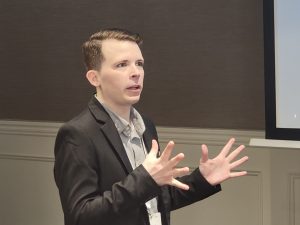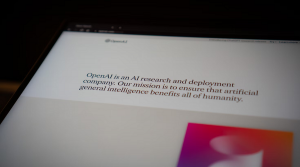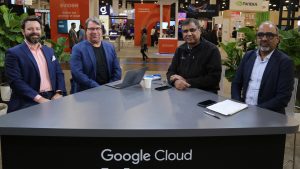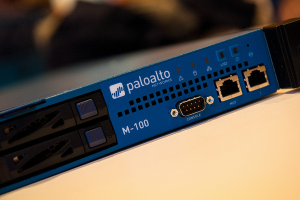CMA’s path to lower costs and query response times simultaneously | #EMCworld
![]() CMA consulting began providing information technology services in 1984. Thirty years later, they host data warehouses and analytics and deliver products that include Oracle RAC clusters and a VQ big data product. At the EMC World 2014 conference in Las Vegas, theCUBE hosts Dave Vallente and John Furrier interviewed CMA chief architect Brian Dougherty to get his take on the tools and structures that help CMA manage and monetize its massive amounts of data. Dougherty described CMA’s challenge as “trying to figure out […] the best way to exploit the technology […] and the data that we have right now.”
CMA consulting began providing information technology services in 1984. Thirty years later, they host data warehouses and analytics and deliver products that include Oracle RAC clusters and a VQ big data product. At the EMC World 2014 conference in Las Vegas, theCUBE hosts Dave Vallente and John Furrier interviewed CMA chief architect Brian Dougherty to get his take on the tools and structures that help CMA manage and monetize its massive amounts of data. Dougherty described CMA’s challenge as “trying to figure out […] the best way to exploit the technology […] and the data that we have right now.”
Vallente asked Dougherty to “paint a picture” of CMA’s IT environment and the applications he uses to serve the business. Dougherty described the CMA IT environment as “very heterogeneous,” explaining, “We have a lot of Oracle RAC clusters, we have big data clusters, we have Hadoop running […], we have security infrastructure, Oracle fusion middleware, a suite of analytic apps running.” He also mentioned that CMA gets “thousands of users coming in every day, running tens of thousands of queries.”
- Hadoop in Real Time
Vallente’s next question centered on CMA’s relationship with Hadoop: “You hear a lot about SEQUEL coming into Hadoop, widening the programing skill sets. Are you seeing that? What does real time mean to you guys?”
Dougherty responded that real-time, to CMA, means “a microsecond. It’s becoming a competitive and strategic advantage.” Furthermore, he explained, that running queries is drastically changing when it comes to speed: “It’s no longer ok to have an analytics environment where people can run a query and wait five seconds for a response […] it requires immediate response time. Microsecond response time.”
When asked where in his “Hadoop infrastructure” Dougherty was applying Flash, the CMA architect said, “We may have Hadoop on some different storage, but we have the high-performance in-memory databases or the high-performance NPP databases sitting on the Flash itself.” He expanded on his statement, mentioning, “some of the core Hadoop is running on a little bit internal slower disks, but the in-memory database is the whole stack. The database part of the stack is running on the Flash.”
The Decision to Use XtremeIO
.
Bouncing off CMA’s need for speed to their Flash storage, Vallente asked Dougherty, “What’s your experience with Flash?”
Dougherty replied that CMA’s interest in Flash was fueled by their “ultra-low latency application needs and requirements.” At the time of this interview, it has been “about fifteen months” since CMA landed on XtremeIO and the company had “been there ever since.” Dougherty described CMA as “pleased with the product, and […] looking at the product just a little differently today, also.”
Dougherty’s response prompted Furrier to ask, “With every new technology there are new experiences, user experiences, outcomes. What do you see as an architect that you’re going for? How do you build for potentially unknown opportunities?”
Dougherty answered that there were two main issues to which CMA needed solutions: Getting the “I/O throughput” they needed and finding a “smaller form factor” alternative to VMAX that still “had the power that a large-scale array had, that we could quickly deploy and deliver.”
Their answer was, as Dougherty explained, to “essentially shrink-wrap our customer with the I/O powering capability we had on a large array. And that was a critical thing, a crucial thing, for us to do.”
- Moving Away from VMAX
Vallente’s next question delved further into CMA’s decision to find an alternative to VMAX, wondering whether the switch made Dougherty nervous. Dougherty replied: “Anyone would be kidding if they said it didn’t make them nervous to move off a Vmax on to another, newer platform.”
Despite this apprehension, Dougherty explained that his faith in the value of EMC products made him confidant: “One of things that is pleasing to us and one of the reasons we’re with XtremIO is the reputation of EMC. […] We know EMC has value, has great research and development, great service.” Besides his trust in EMC’s reputation, Dougherty mentioned that CMA values XtremIO’s “scale-out performance” and that the company has come to trust XtremIO “just like a VMAX.”
The XtremIO Stack
.
Pressing further, Vallente asked for details about the state of the XtremeIO stack. Dougherty related that when CMA “first started using XtremIO, [they] were looking at performance, performance, performance.” But now, because CMA has been monitoring XtremIO for months, they have “grown to look more at the value-add features that there are.”
![]() The main feature Dougherty focused on was snapshot, because CMA often has “50 development projects going on at any point in time, […] it’s very difficult for us to support 5 – 10 different images of the production database and to serve that out to the different development groups that are there. With snapshots we can now do that easily and quickly and we don’t have to compromise performance […].”
The main feature Dougherty focused on was snapshot, because CMA often has “50 development projects going on at any point in time, […] it’s very difficult for us to support 5 – 10 different images of the production database and to serve that out to the different development groups that are there. With snapshots we can now do that easily and quickly and we don’t have to compromise performance […].”
When asked to talk a little about “copy creep,” which, Vallente noted, “a lot of people complain […] gets expensive,” Dougherty explained on his opinion: “It’s the meta data. It’s the value-add to the operating system itself. With XtremIO, it’s possible to leverage a smaller set of core Flash data and to essentially multiply or project very efficiently out to a heterogeneous group of users and environments.” He also mentioned increased efficiency and low overhead as other main selling points.
- Using Flash Storage to Drive Down Costs
Vallente’s next question asked Dougherty to consider the balance of “spending a little bit more on Flash and then reducing the number of cores you may require,” particularly, Vallente noted, “because Oracle license and maintenance costs are based on cores and often times it’s 50+ percent of an overall total cost of ownership.
In response, Dougherty broke down the changes CMA has seen after moving towards Flash: “We can shift to smaller hardware, get better utilization, reduce the core set, and we’re benefiting from the ability to half the cost on a Linux […].” He added that “We’re able to reduce that core count confidently because we have power in the back end, so it comes right through.”
When asked about training data scientists within CMA, Dougherty described the process as something of a “retrofitting,” an adjustment to Flash, “and some of the other technologies,” that allows them “to iterate much more quickly through the data. You know, not run a query and wait for three hours then run a query again, but actually run a query 15 – 20 times within a five minute span.”
To SQL or Not to SQL
.
When asked about his take on the NoSQL trend, Dougherty expressed his confidence in established technology, saying, “[…] 30 years of optimizing technology is not something you can replace. So some things will be fine with no SQL, some things will be fine with kind of lightweight SQL, but some things are going to continue to require that optimizer depth and that will continue to stay in the NVP, in memory databases, or in the Oracle databases.”
Responding to Vallente’s question about what makes a “good fit” for SQL, Dougherty supposed: “Something quick and dirty that doesn’t require a lot of elegance or complexity in the query path. So, kind of sifting through data quickly, taking a quick, broad look at it, and then, maybe at that point you would load it into a relational database and NVP database and do more in-depth mining and analytics.”
- The Role of Visualization
Considering the role visualization plays at CRM, Dougherty said, “We’re still struggling with that ourselves. ” He described the challenge as “drowning in data flowing in, but we’re having a very difficult time sifting through that.” While Dougherty believes “there are some very good visualization technologies,” he still believes “there’s some work to do in that environment.”
A message from John Furrier, co-founder of SiliconANGLE:
Your vote of support is important to us and it helps us keep the content FREE.
One click below supports our mission to provide free, deep, and relevant content.
Join our community on YouTube
Join the community that includes more than 15,000 #CubeAlumni experts, including Amazon.com CEO Andy Jassy, Dell Technologies founder and CEO Michael Dell, Intel CEO Pat Gelsinger, and many more luminaries and experts.
THANK YOU













